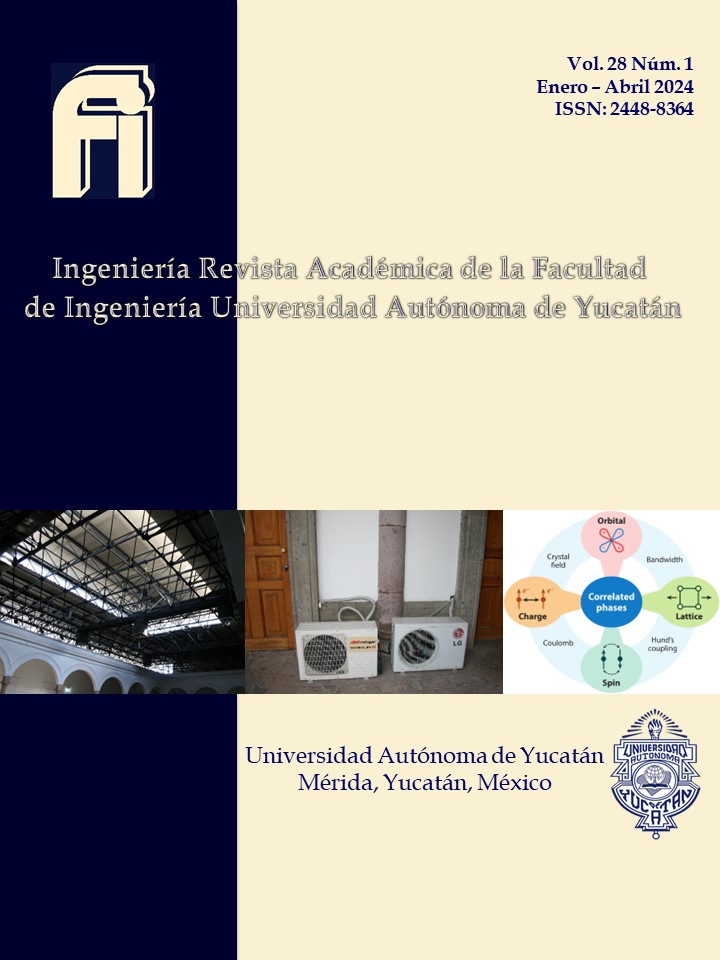Ecuación para el diseño de reactores de electrocoagulación con flujo vertical ascendente
Resumen
En este trabajo, se comparan los resultados experimentales de un reactor de electrocoagulación de flujo vertical con las predicciones de una ecuación de diseño propuesta. Para generar el espacio muestral y examinar el impacto de las variables tales como el número de placas (Np), la densidad de corriente (i), el número de módulos (Nm) y la separación (s) de electrodos en los resultados de la ecuación de diseño, se utilizó el modelo experimental 2k. Estudios previos han investigado la relación entre la electrocoagulación y las pérdidas de carga hidráulica en el sistema. Sin embargo, en este estudio, hemos enfocado nuestro análisis en la densidad de corriente eléctrica, que definimos como la relación entre la intensidad de corriente y el área de superficie de la placa, así como en el número de placas, con el objetivo de determinar su influencia en la ecuación de diseño. Nuestro análisis experimental reveló que estos factores son los más sensibles en la ecuación de diseño.
Citas
[2] J. Rodriguez, Evaluación de reactores de electrocoagulación para el tratamiento de agua de purga de torres de enfriamiento, Master’s thesis, Universidad Nacional Autónoma de México (2014).
[3] J. Hakizama, B. Gourich, M. Chafi, Y. Stiriba, C. Vial, P. Drogui, J. Naja, Electrocoagulation process in water treatment: A review of electrocoagulation modeling approaches, Desalination 404 (2017) 1–21. doi:https: //doi.org/10.1016/j.desal.2016.10.011.
[4] P. Holt, G. Barton, C. Mitchell, The future for electrocoagulation as a localized water treatment technology, Chemosphere 59 (3) (2005) 355–367. doi:https://doi.org/10.1016/j.chemosphere.2004.10.023.
[5] M. Emamjomeh, M. Sivakumar, Review of pollutants removed by electrocoagulation and electrocoagulation/flotation processes, Journal of Environment Management 90 (5) (2009) 1663–1679. doi:https://doi. org/10.1016/j.jenvman.2008.12.011.
[6] Piña-Soberanis, M.-D. A., C. González-Ramírez, F. Prieto-García, A. Guevara-Lara, J. García-Espinosa, Revisión de variables de diseño y condiciones de operación en la electrocoagulación, Revista Mexicana de Ingeniería Química 10 (2) (2011) 257–271.
[7] V. Khandegar, A. Saroha, Electrocoagulation for the treatment of textile industry effluent – a review, Journal of Environmental Management 128 (15) (2013) 949–963. doi:https://doi.org/10.1016/j.jenvman.2013. 06.043.
[8] O. Sahu, B. Mazumdar, P. Chaudhari, Treatment of wastewater by electrocoagulation: a review, Environmental Science and Pollution Research 21 (2013) 2397–2413. doi:https://doi.org/10.1007/s11356-013-2208-6.
[9] D. Ghernaout, A. Alghamdi, B. Ghernaout, Electrocoagulation process: A mechanistic review at the dawn of its modeling, Journal of Environmental Science and Allied Research 2 (1) (2019) 1–17.
[10] D. Ghosh, C. Medhi, M. Purkait, Treatment of fluoride containing drinking water by electrocoagulation using monopolar and bipolar electrode connections, Chemosphere 73 (9) (2008) 1393–1400. doi:https://doi.org/ 10.1016/j.chemosphere.2008.08.041.
[11] A. Deshpande, S. S., R. S., Treatment of high-strength pharmaceutical wastewater by electrocoagulation combined with anaerobic process, Water Science and Technology 61 (2) (2010) 463–472. doi:https: //doi.org/10.2166/wst.2010.831.
[12] S. Gelover-Santiago, S. Pérez-Castrejón, A. Martín-Domínguez, A. Montes-Brito, I. Villegas-Mendoza, Current density as a master variable in designing reactors, Procedia Chemistry 12 (2014) 66–72. doi:https://doi.org/10.1016/j.proche.2014.12.043.
[13] O. Larue, E. Vorobiev, C. Vu, B. Durand, Electrocoagulation and coagulation by iron of latex particles in aqueous suspensions, Separation and purification Technology 31 (2) (2003) 177–192. doi:https://doi.org/ 10.1016/S1383-5866(02)00182-X.
[14] M. Mollah, P. Morkovsky, J. Gomes, M. Kesmez, J. Parga, D. Cocke, Fundamentals, present and future perspectives of electrocoagulation, Journal of Hazardous Materials 114 (1–3) (2004) 199–210. doi:https: //doi.org/10.1016/j.jhazmat.2004.08.009.
[15] A. Golder, A. Samanta, S. Ray, Removal of cr3+ by electrocoagulation with multiple electrodes: bipolar and monopolar configurations, Journal of Hazardous Materials 141 (3) (2007) 653–661. doi:https://doi.org/10.1016/j. jhazmat.2006.07.025.
[16] K. Brahmid, W. Bouguerra, B. Hamrouni, E. Elaloui, M. Loungou, Z. Tlili, Investigation of electrocoagulation reactor design parameters effect on the removal of cadmium from synthetic and phosphate industrial waster water, Arabian Journal of Chemistry 12 (8) (2019) 1848–1859. doi:https://doi.org/10.1016/j.arabjc. 2014.12.012.
[17] G. Chen, Electrochemical technologies in wastewater treatment, Separation and Purification Technology 38 (2004) 11–41. doi:https://doi.org/10.1016/j.seppur.2003.10.006.
[18] I. Villegas-Mendoza, Influencia de parámetros hidráulicos y fisicoquímicos en la eficiencia de remoción de sílice mediante un sistema de electrocoagulación, Master’s thesis, Universidad Nacional Autónoma de México (2011).
[19] S. Gelover-Santiago, S. Pérez-Castrejón, A. Martín-Domínguez, V.-M. I.E., Electrogeneration of aluminium to remove silica in water, Water Science and Technology 65 (3) (2012) 434–439. doi:https://doi.org/10.2166/ wst.2012.865.
[20] S. Gelover-Santiago, Ahorro de agua mediante recuperación de purgas en torres de enfriamiento a través de la eliminación de microorganismos, sílice y otras especies químicas, Tech. rep., Instituto Mexicano de Tecnología del Agua (2013).
[21] G. Sotelo, Hidráulica General Vol. 1, Limusa, 1997.
[22] T. Ostanina, V. Rudoi, N. Ostanin, E. Kosheleva, Calculation of current strength in reactor with combined anodes, Russian Journal of Applied Chemistry 74 (2001) 338–340. doi:https://doi.org/10.1023/A: 1012763326465.
[23] H. Enríquez, El ABC de las intalacines el ́ectricas residenciales, Limusa, 2009.
[24] M. Kleidorfer, Uncertain calibration of urban drainage models: a scientific approach to solve practical problems, Innsbruck University Press, 2010.

Esta obra está bajo licencia internacional Creative Commons Reconocimiento-NoComercial 4.0.
Avisos de derechos de autor propuestos por Creative Commons
1. Política propuesta para revistas que ofrecen acceso abierto
Aquellos autores/as que tengan publicaciones con esta revista, aceptan los términos siguientes:
- Los autores/as conservarán sus derechos de autor y garantizarán a la revista el derecho de primera publicación de su obra, el cuál estará simultáneamente sujeto a la Licencia de reconocimiento de Creative Commons que permite a terceros compartir la obra siempre que se indique su autor y su primera publicación esta revista.
- Los autores/as podrán adoptar otros acuerdos de licencia no exclusiva de distribución de la versión de la obra publicada (p. ej.: depositarla en un archivo telemático institucional o publicarla en un volumen monográfico) siempre que se indique la publicación inicial en esta revista.
- Se permite y recomienda a los autores/as difundir su obra a través de Internet (p. ej.: en archivos telemáticos institucionales o en su página web) antes y durante el proceso de envío, lo cual puede producir intercambios interesantes y aumentar las citas de la obra publicada. (Véase El efecto del acceso abierto).

